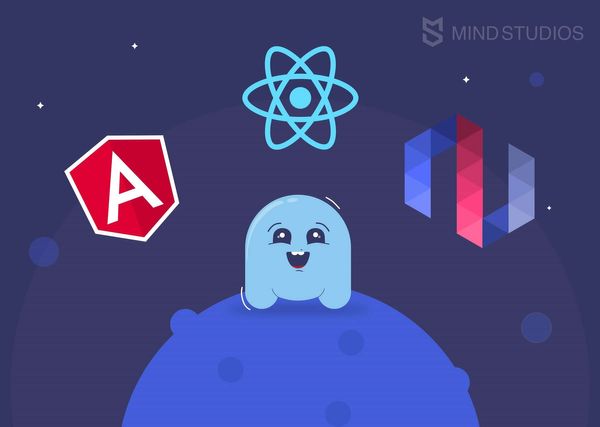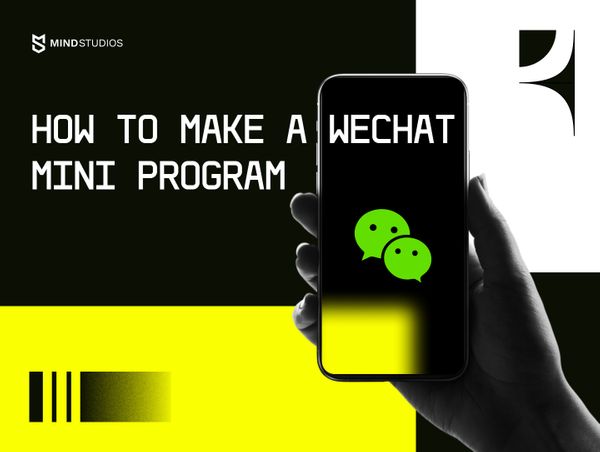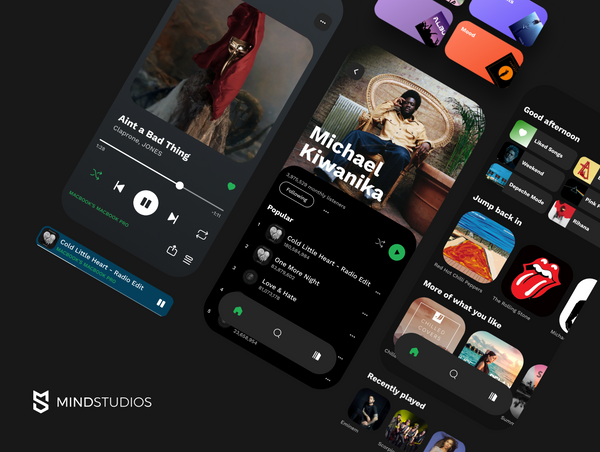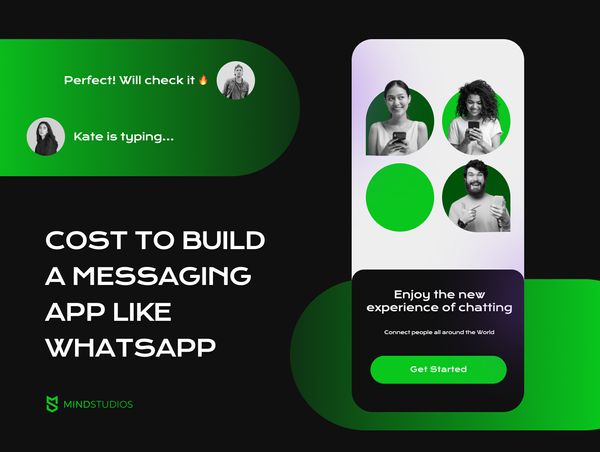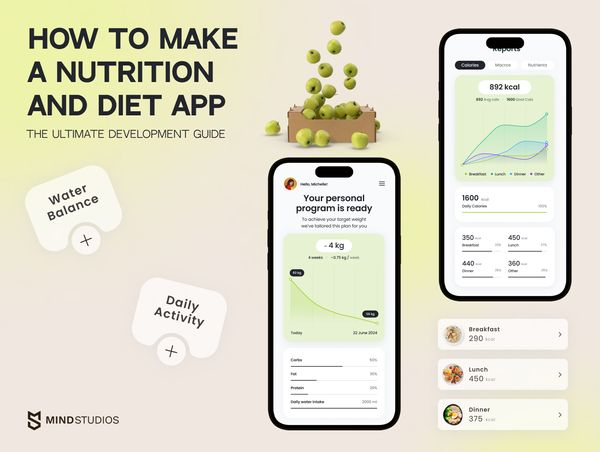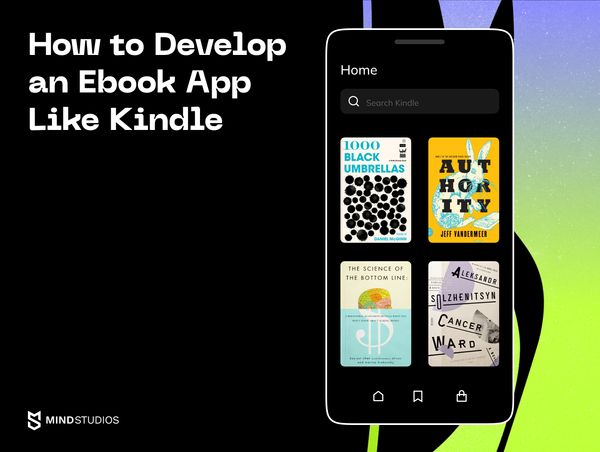![How to Create an Photo Sharing App like Instagram [Guide 2024]](https://themindstudios.com/blog/content/images/size/w600/2022/08/01.-Cover--18-.jpg)
Being the second most favorite social media around the globe and having around 2 billion monthly users, Instagram has definitely earned the title of the most successful photo-sharing app on the market.
So, can anyone actually compete with that, and is developing an app like Instagram a sensible idea? And if so, is it possible to learn how to make an app like Instagram and succeed?
In this article, we explain why Instagram no longer can be considered solely a photo-sharing app, dig into the challenges it’s facing now, and highlight the lessons we can learn from the app’s history.
Moreover, through the lens of Mind Studios’ own app development experience, we give an answer to the ultimate question of how to create an app like Instagram.
Thoughts that Instagram is no longer a photo sharing app
Today, the idea of building an Instagram-like platform doesn’t mean you have to create a photo-sharing app, because this particular app has grown into something much more complex.
Instagram is now a multi-faceted social media platform that encompasses photo and video content, live broadcasts, product promotions and e-commerce elements, a text text-based conversation functionality, and more.
While Instagram's core identity still revolves around visual content, it also tries to keep up with other social media platforms, which often leads to significant strategy shifts. Last year, Instagram made it clear their top priority was Reels, a video feature that was supposed to allure TikTok users.
Short-form video content has become Instagram’s priority number one, which resulted in a backlash. Full-screen display and a new algorithm that pushed Reels videos got criticized by major influencers with millions of followers on Instagram. For instance, Kylie Jenner shared a meme on her Stories that read: “Make Instagram Instagram again. Stop trying to be TikTok. I just want to see cute photos of my friends. Sincerely, everyone.”
Is it worth building an app like Instagram in 2023?
In the era of social media communication, it’s no wonder that so many tech startups aspire to become the next Facebook, Instagram, or TikTok.
According to Digital 2022 Global Overview Report by Dataportal, 58.4% of the global population uses social media, on average spending 2 hours 27 minutes on various platforms. And Instagram plays a significant role in this overall picture, with 14.8% of internet users naming it their favorite social media (which makes it the second favorite platform after WhatsApp).
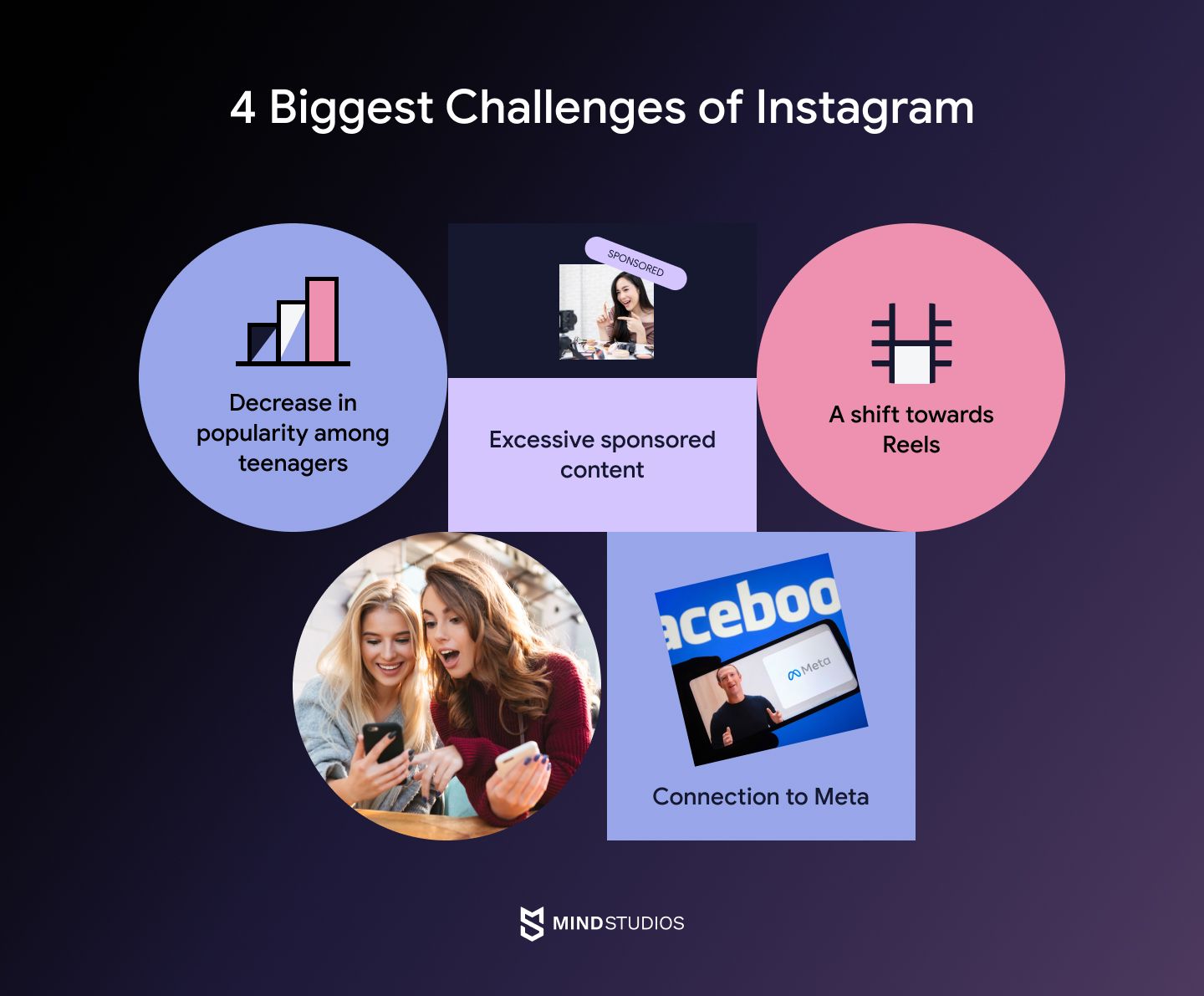
An idea of building another photo-sharing application and competing with Instagram, which currently has over 2 billion active users, might seem overly ambitious. However, some argue that the future isn’t looking very bright for the platform. Here are the four biggest challenges Instagram is facing right now:
-
Decrease in popularity among teenagers
In 2015, Piper Jaffray survey of American teenagers showed that one-third of this demographic group considered Instagram as their most important social media platform. Just six years later, in 2021, the same company conducted another study only to discover that now only 22% of teens named Instagram as their favorite social network, which meant it came in third after Snapchat and TikTok.One of the reasons behind that might be the toxic influence Instagram has on teens, especially teenage girls. Internal research conducted by Facebook showed that compared to Snapchat, TikTok, and other platforms popular with teens, social comparison is worse on Instagram.
That same research showed that teens who struggle with mental health say Instagram makes it worse. Therefore, unless Meta puts significant effort into changing the toxic culture of Instagram, chances are the younger generation will continue to switch to social networks that don’t influence their mental wellbeing as much.
-
Excessive sponsored content
Instagram stopped being just a photo-sharing app a while ago. One of the major decisions that contributed to this shift happened back in 2016 when the in-feed shopping feature was introduced. Since then, e-commerce has become a significant part of Instagram, with tons of sponsored content and recommended posts from people (and brands) users don’t even follow.So, how much has this type of content actually grown? In 2016, 1.26 million brand sponsored influencer posts appeared on Instagram. In 2020, this number grew to 6.12 million posts.
In June 2022, Stan Schroeder, senior editor at Mashable, wrote a column on his experience with Instagram’s algorithm, claiming that he had to scroll past six ads before he got to a post by someone he actually followed. The fact that Instagram’s algorithm actually prioritizes those posts is one of the reasons the platform’s popularity is decreasing.
-
A shift towards Reels
Another indication of Instagram’s decision to move away from photo-sharing is its attempt to allure TikTok users by introducing Reels, a video feature. Moreover, it seems that short-form video content is becoming Instagram’s priority number one, which resulted in a backlash.Full-screen display and a new algorithm that pushed Reels videos got criticized by major influencers with millions of followers on Instagram. For instance, Kylie Jenner shared a meme on her Stories that read: “Make Instagram Instagram again. Stop trying to be TikTok. I just want to see cute photos of my friends. Sincerely, everyone.”
-
Connection to Meta
Acquired by Facebook, Inc. back in 2012, Instagram is now a part of Meta, an American multinational technology conglomerate. This connection doesn’t do the platform any favors due to Facebook and Cambridge Analytica data privacy scandal and other data breach accusations.Naturally, the social network isn’t trusted that much, at least among Americans. According to The Washington Post poll conducted in 2021, 60% of Internet users there distrust Instagram, and only 19% do, with 20% expressing no opinion on the matter.
All the abovementioned tendencies lead to a conclusion that it makes sense to try and make a social media app like Instagram, as long as it is:
- actually a photo- or video-sharing and not an all-in-one application
- more than just a replica of Instagram or other social media platforms
- inclusive and mindful of its impact on the users
- responsive to its users’ feedback
- cautious about its security policy and monetization strategies.
Development vector when creating an application like Instagram
In April 2022, Adam Mosseri, head of Instagram, announced that the platform is moving away from being primarily a photo-sharing app. In his video, Mosseri acknowledged the success of TikTok and YouTube, the app’s competitors, and declared the new vector for Instagram, which is video content. And even though months later the social network was forced to back down on the planned updates after extensive criticism, there’s a lesson to be learned here.
Social networks don’t have to chase two rabbits and try to become every social platform out there. All its owners and executives have to do is thoroughly study its audience’s needs and pain points. Most likely this would lead to choosing just one focus instead of trying to copycat every popular social media out there.

So, which ways can you go when building a social network app? While there are four main development vectors Instagram has picked, we recommend focusing on just one of the following if you decide to make an app like Instagram of your own.
- Photo-sharing app
The original idea behind Instagram was sharing photos, and the need for such an app hasn’t worn off over the years. If you pick this development vector, your app can include various photo editing features, like resizing, filters, masks, and more. Categorizing content by hashtags, folders, and mood boards can also be of use. The main thing here is to make photos the main star of the app, which you can scale with additional features later on. - Video-sharing app
This vector is somewhat similar to the first one, except, in this case, all the tools the app provides are for creating video content. In addition to visual editing, it might include various sound effects, voice changers, a music library, and even AR/VR tools to help users follow their imagination even further. - Social media app
The primary focus of this vector is communication. This means, the application you build will need to have a built-in messenger, commenting, video- and/or audio broadcasts, Q&As, polls, content co-creation, and basically any other features that encourage interaction between users. - Social eCommerce app
You might wonder how an eCommerce platform can be social, but actually, Instagram is the perfect visualization of that. It doesn’t simply sell products but rather plays the role of a link between brands, influencers that cooperate with those brands, and users. Social eCommerce platforms help brands increase their outreach and build trust through cooperating with influencers who take on the role of brand ambassadors.
6 cornerstones of Instagram-like app success

There are six elements that are crucial if you want to create a mobile app like Instagram. Let’s study each of them more closely.
-
Post is any type of content you are going to post on the app, whether it’s an image, a text image, a URL leading to an outbound resource, or a video URL with a thumbnail for it. In the case of Instagram and Facebook, this can also be a permanent post on the feed or a Story that disappears within 24 hours.
There normally are 3 types of posts on Instagram-like platforms: user posts, ad posts, and system posts. In the Post area, you can run certain commands, including post (create a new one), repost, edit, delete, share and comment, so, all-in-all, you can configure the post’s lifecycle with these commands.
-
User is anyone (a person, a company, an organization, etc.) who gets access to the app’s functionality via registration. This might be a business account, a regular registered user, a system user (like an admin or bot), and so on. A user’s profile normally contains 4 basic fields of information:
- Profile info (personal info, avatar, nickname, hashtag, geolocation, etc.)
- Settings (change/remove password, email, notifications)
- Activity (posts, likes, comments, favorites, etc.)
- Followers and followees — the users being followed and the users who follow other users updates
When it comes to functions, users can block other users, add, follow, favorite or like them, send messages and tag them in a comment by using a specific hashtag.
-
Message is the type of user-to-user interaction that happens on any application with social network elements. This can be a direct message, a comment, or even an emoji reaction. This interaction can also have many forms, like simple text, emojis, links, images and videos, hashtags, and files.
-
User-generated content and tools to create it is the fourth essential cornerstone needed for photo-sharing app development. Apart from uploading pictures and videos in different formats, content functions also include editing options. Filters, masks, rotation, brightness/contrast, VR/AR, or sound effects — photo and video editors within your app may have countless features.
-
Streaming is the form of connecting users in real-time via video or audio broadcasting. It cannot be prerecorded and allows other users to interact with the streamer via the comments section. This feature is common for many social media, including Facebook, Twitter, YouTube, and TikTok.
-
Reels are the cornerstone we couldn’t skip because currently, it’s the feature Instagram is placing its stakes on. Basically, these are entertaining short full-screen vertical videos, created with various filters, audio tracks, stickers, interactive backgrounds, and other editing tools. They are somewhat similar to Instagram Stories, however, they do not disappear in 24 hours and are available on users’ Instagram pages unless they decide to delete them.
Throughout Instagram’s history, there were numerous updates, some of which didn’t make it to 2022 (like the IGTV feature). Therefore, we focused on the cornerstones that stuck and are essential to Instagram’s 2023 version.
How to make an app like Instagram in 5 steps
So, how to develop an app like Instagram and at the same time make sure it’s an exceptional platform that will bring you revenue? Here are five steps that will help you achieve your business goal.
Step 1. Finding a trustworthy full-cycle development team
Making this decision usually depends on the development needs, the project’s scale, and the budget for it. Developers’ hourly rates vary greatly depending on their location, with US-based developers charging $100-150 per hour, Eastern European companies charging $40-50, and South-Asian developers — $30.
No matter which country your candidates are from, it’s critical to check their experience with similar projects, read reviews on such platforms as Clutch and GoodFirms, contact previous clients if necessary, and conduct thorough interviews. In addition to that, make sure you include all the essential cooperation details in the official contract.
You can get more tips on hiring the right team for your project in our article “How to outsource mobile app development in 2023.”
Step 2. Working on the discovery stage
While time-wise, this stage takes up to 5% of the development process, it lays the foundation for the whole project. During this stage, the clients and the development team who will make a platform like Instagram:
- Evaluate the idea and make sure everyone is on the same page
- Conduct all-encompassing market research and analyze the competitors
- Dive into the needs and pain points of the target audience
- Finalize the concept of the idea and come up with tech solutions that will makethe app stand out and appeal to users.
Approximate time and cost: 80 – 100 hours, the cost starts at $3,600.
Step 3. Creating UI/UX design
After the team established users’ needs, it’s time to create solutions for them. UI/UX designers work with the app’s features and visual design, and in the end, create visual prototypes of every single screen of the app.
For instance, for a photo-sharing app, the user interface would most likely be simple and minimalistic, with a focus on the pictures shared there. As for UX design, a social photo-sharing app like Instagram would include the following features:
- Authorization
- Profile settings
- Photo uploading and deleting
- Photo editing
- Like, save, and share features
- Commenting
- Messaging
- Geolocation
- Search
Approximate time and cost: 160 – 240 hours, the cost starts at $7,200.
Step 4. Defining the tech stack for the app, developing, and testing it
After the high-fidelity prototypes, created by UI/UX designers, are approved, it’s time to make them into a functioning app. Before the team of developers actually start coding, they first define the tech stack for the app. Here’s what Instagram’s tech stack looks like:
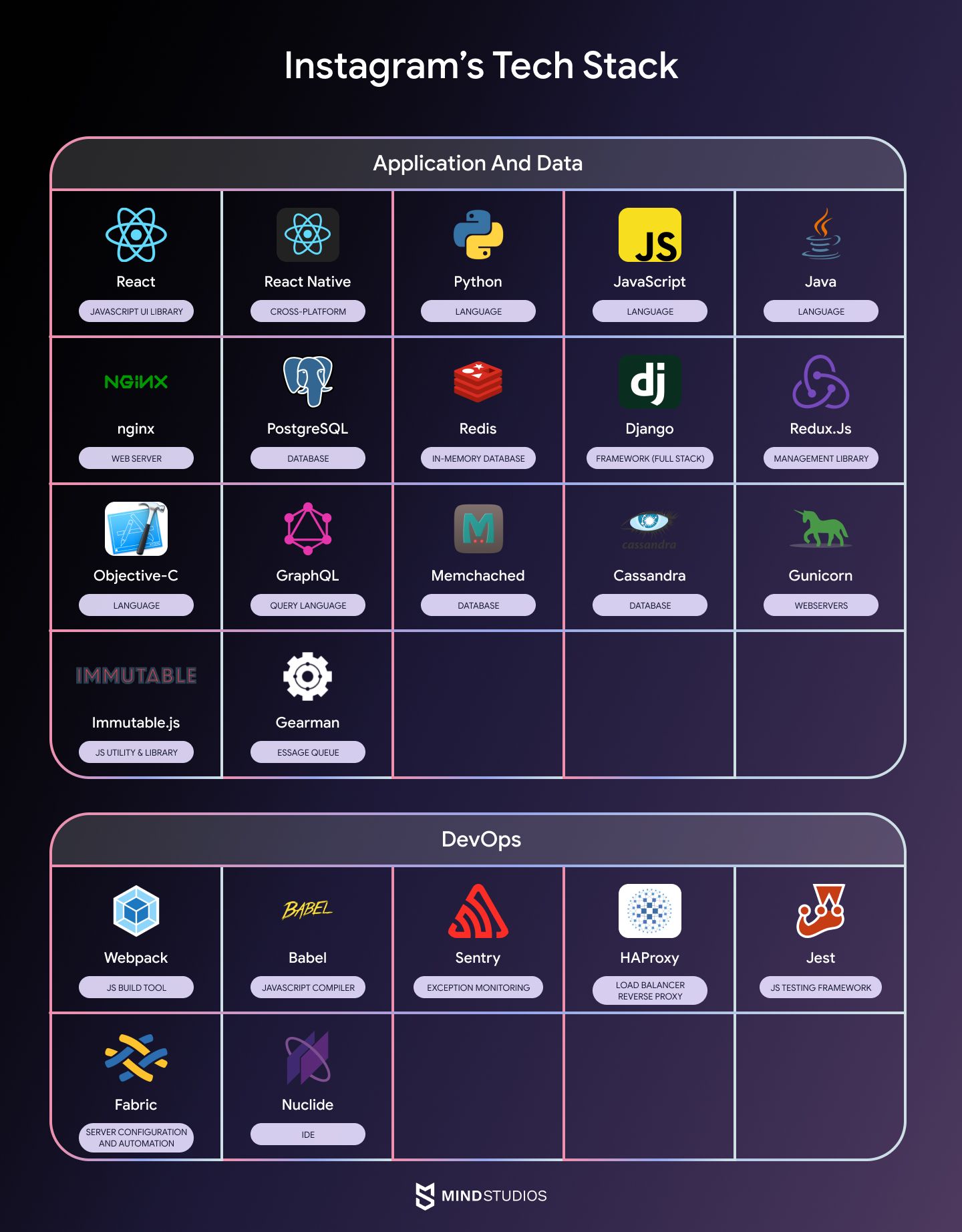
After the app is complete, the quality assurance specialists test it out and report on any bugs they find so that the developers can fix those. When everything seems to work flawlessly, the app is ready for launch.
Approximate time and cost:
- 680 – 800 hours for Android or iOS platforms. The cost starts at $30,600 per platform
- 720h – 800 hours for server-side (API) development. The cost starts at $32 400
- 320h – 400 hours for project management and testing. The cost starts at $14 400
Step 5. Marketing for your own app like Instagram
Marketing is an after-launch stage, which is essential to promote your product to the target audience and secure the app’s success. The app marketing strategy might include such components as
- app store optimization
- PR outreach
- cooperation with influencers
- media coverage
- online and offline advertising
Approximate time and cost: To create an app like Instagram and make it succeed, the marketing process should be in progress for as long as the platform is up and running. As for its price, in the first year after the launch, app marketing can cost you up to 50% of the development cost. However, the price goes down significantly with each subsequent year.
To sum up, developing a photo-sharing app (which will include a discovery stage, UI/UX design, development, testing, and project management) can cost around $118, 600 for all mobile platforms (both iOS and Android). This number is based on a $45 hourly rate. You can get a more accurate estimate after contacting our team.
Cost to build an app like Instagram
The cost to make an app like Instagram depends on many factors, such as the platform’s complexity, features, choice of technologies, and the choice of the development team, Here, we’ve made an estimate based on how much an app of a medium complexity could cost you when outsourcing to a team like Mind Studios.
| Stage | Time, hours | Cost, USD |
|---|---|---|
| Discovery stage | 80 – 100 | $3,600+ |
| UI/UX design | 160 – 240 | $7,200+ |
| iOS development | 680 – 800 | $30,600+ |
| Android development | 680 – 800 | $30,600+ |
| Backend development | 720 – 800 | $32,400+ |
| Testing and project management | 320 – 400 | $14,400+ |
| Total | 2,640 – 3,140 | $118,800+ |
If you want to find out a more precise estimate of how much it will cost you to build an app like Instagram based on your specific idea, feel free to reach out. Our business development team will be happy to provide you with more accurate numbers after a free consultation.
KPIs to track for an app like Instagram
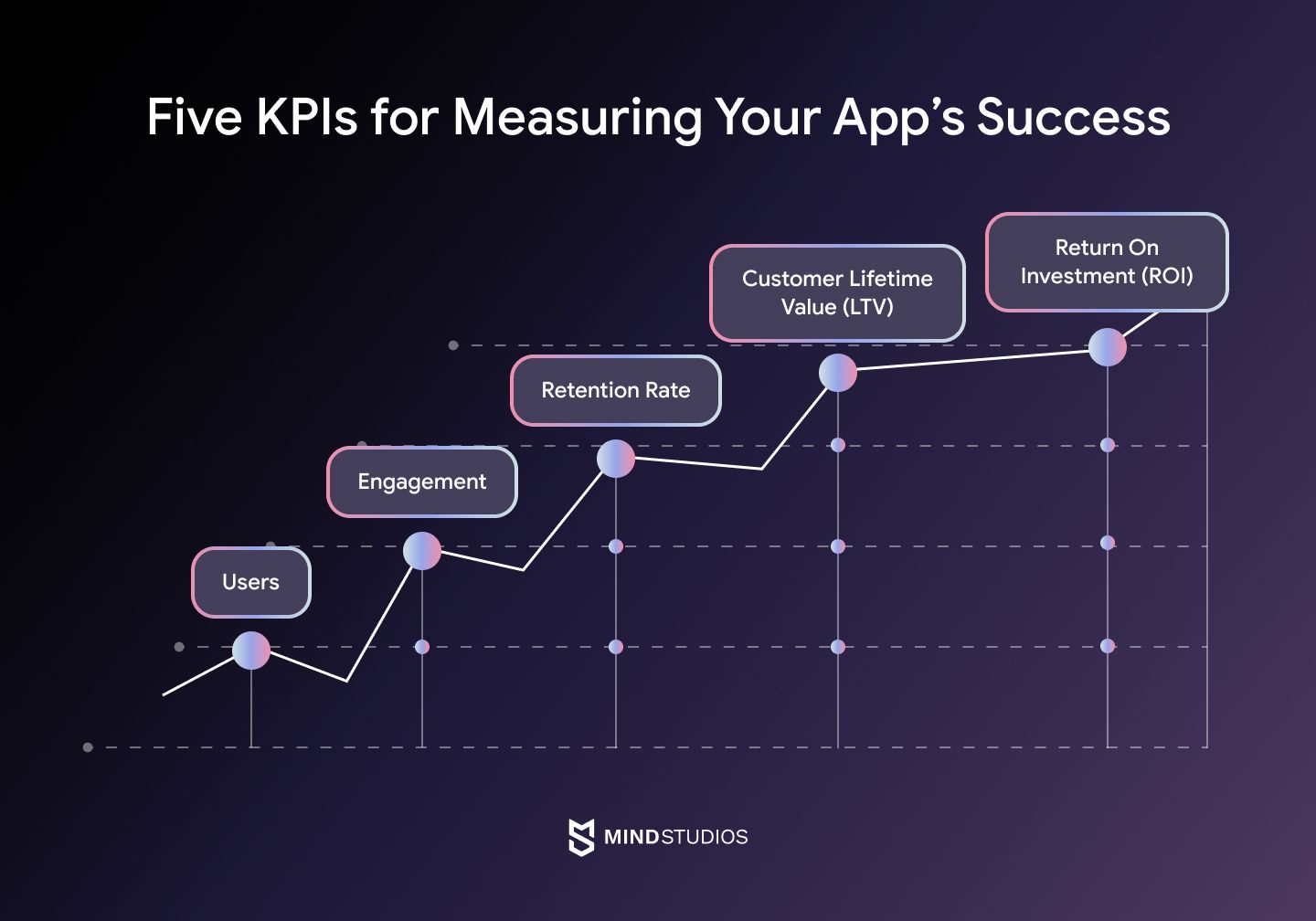
So, let’s assume you’ve already launched your photo-sharing app like Instagram. What’s next? After the app is up on app stores, it’s crucial to closely monitor users’ feedback, make necessary updates if needed, and measure the app’s performance. That’s where these five key performance indicators (KPIs) come in handy.
1. Users
This metric can actually consist of different KPIs, such as monthly active users (MAU) and daily active users (DAU).
MAUs are users that log on to the app at least once in a 30-day period. However, to know whether user acquisition has been successful, you will need to monitor this metric regularly and check if those users come back. DAUs, on the other hand, can show you how many users are actually highly engaged on a regular basis.
To reach the desired number of active users, it’s advisable to start marketing the app on social media even before its development. In addition, you can introduce referral programs, reward the most active users, and work with influencers to enhance user growth.
2. Engagement
After you’ve determined the quantity of users, it’s time to check the quality of the user acquisition. To do so, you can check daily sessions per daily active user and killed sessions, the average amount of time users spend on the app, and the number of likes, comments, and other interactions they make. These are signs that point out how engaged and loyal your users really are.
You can also determine the stickiness of your app, which is another metric that shows how engaged and likely the users are to use the app frequently. To do this, you simply need to divide your DAUs by MAUs. The closer the two numbers are, the higher the quality of user acquisition is.
3. Retention rate
Basically, the retention rate is the percentage of users who continue using an app after installing it over a given time period. You can determine the retention rate for your platform by dividing monthly active users by monthly installs.
What’s a good retention rate? The answer may vary depending on the industry and type of application. On average, mobile apps have a 30-day retention rate of 42% and a 90-day retention rate of 25%. These benchmarks are also true for media and entertainment apps in particular.
The metric opposite to retention is called the churn rate, which shows how many users are quitting the app in a given period of time. Therefore, if your 30-day retention rate is 40%, the 30-day churn rate is 60%.
There are a couple of tools that can help you improve the retention rate, including engaging and correctly scheduled push notifications, limited-time offers, quizzes, etc.
4. Customer lifetime value (LTV)
Customer LVT is a mobile app measure of a user's value over a given time period. This KPI is directly related to the revenue that your company generates through paid subscriptions, in-app purchases, or other actions connected to the monetization model.
This indicator is often compared with the cost per acquisition (CPA), a metric that indicates the money spent on advertising which results in a user installing the app. The higher the LTV is in relation to CPA, the higher the chances that your app will pay off.
5. Return on investment (ROI)
This metric shows the return on the money you’ve spent on building the app, marketing it, and basically any other activities aimed at business growth.
So, how can you calculate the return on investment? While there are a couple of methods, one of the simplest ones is to divide the net return on investment by the investment cost and multiply it by 100%.
You can also define the customer lifetime value to customer acquisition cost ratio (LTV:CAC). Then, this ratio should be higher than 1, ideally — 3, so that you can keep the business growing.
Following and analyzing the abovementioned KPIs will help you improve business and marketing strategies, and simply keep you informed of how the mobile app is doing.
Monetize your Instagram-like app
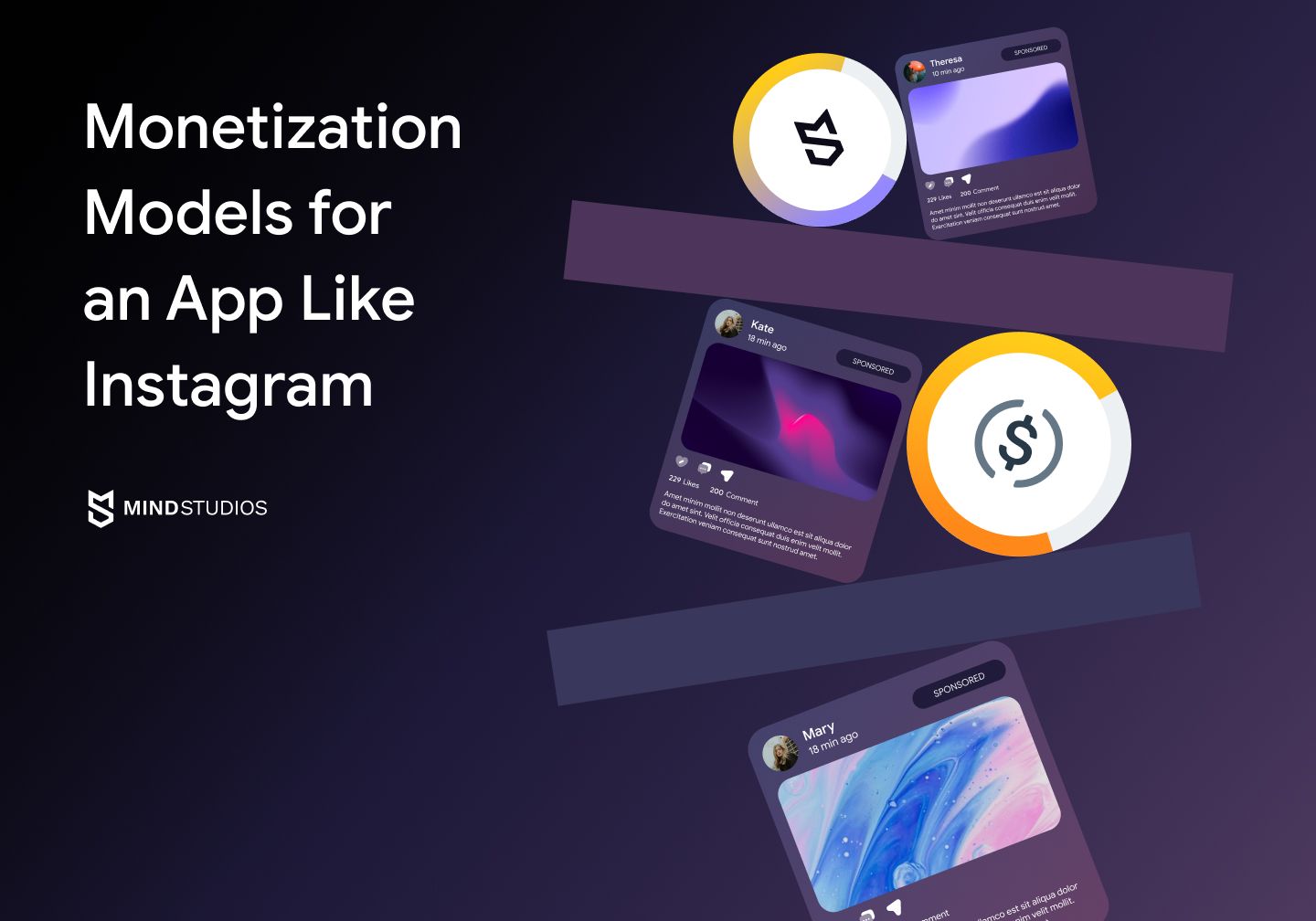
This might be surprising, but during the first two years after its launch, Instagram didn’t have a clear monetization strategy. Later on, they resolved this issue by allowing users and businesses on the app to advertise their content and products. However, this is not the only way to monetize your app.
Based on the experience of Instagram and other similar platforms, we’ve singled out three main monetization models you can use for your photo-sharing app.
-
Provide a platform for advertising
The most obvious solution, which is Instagram’s main source of revenue, is providing brands and influencers on your app with advertising opportunities. These include a carousel and video ads, and sponsored posts with a CTA button. You can choose it as the main monetization model or a supplementary one, used in combination with other methods on the list. -
Use a freemium model
This monetization model means that you give users a choice between using your app for free or purchasing its improved version with perks. For instance, since one of the things Instagram is criticized for are ads and tons of sponsored content, you can offer an ad-free version, just like YouTube does.The subscription might also include access to premium filters, premium content from users’ favorite creators, or additional tools to analyze and improve content posted by users.
-
Introduce in-app purchases
Depending on the development vector you pick, there are a number of services and digital products you can sell via your app. If you decide to create an Instagram-like app, these might include various filters and effects that help enhance the content users create.A vivid example of this monetization is the VSCO platform, popular for its filters as well as photo and video editing features.
Mind Studios’ experience in social network app development
Mind Studios’ team is no stranger to building apps that are aimed at connecting people, our project SternFit being one of such platforms. But what’s the connection between a startup for athletes and a social media app like Instagram?
The primary goal of SternFit was to unite athletes willing to create their own exercise and dietary programs. However, over the course of research and development, it also took on a role of a social network for athletes and those willing to get fit. As a result, it grew into a fitness-based social application for athletes.
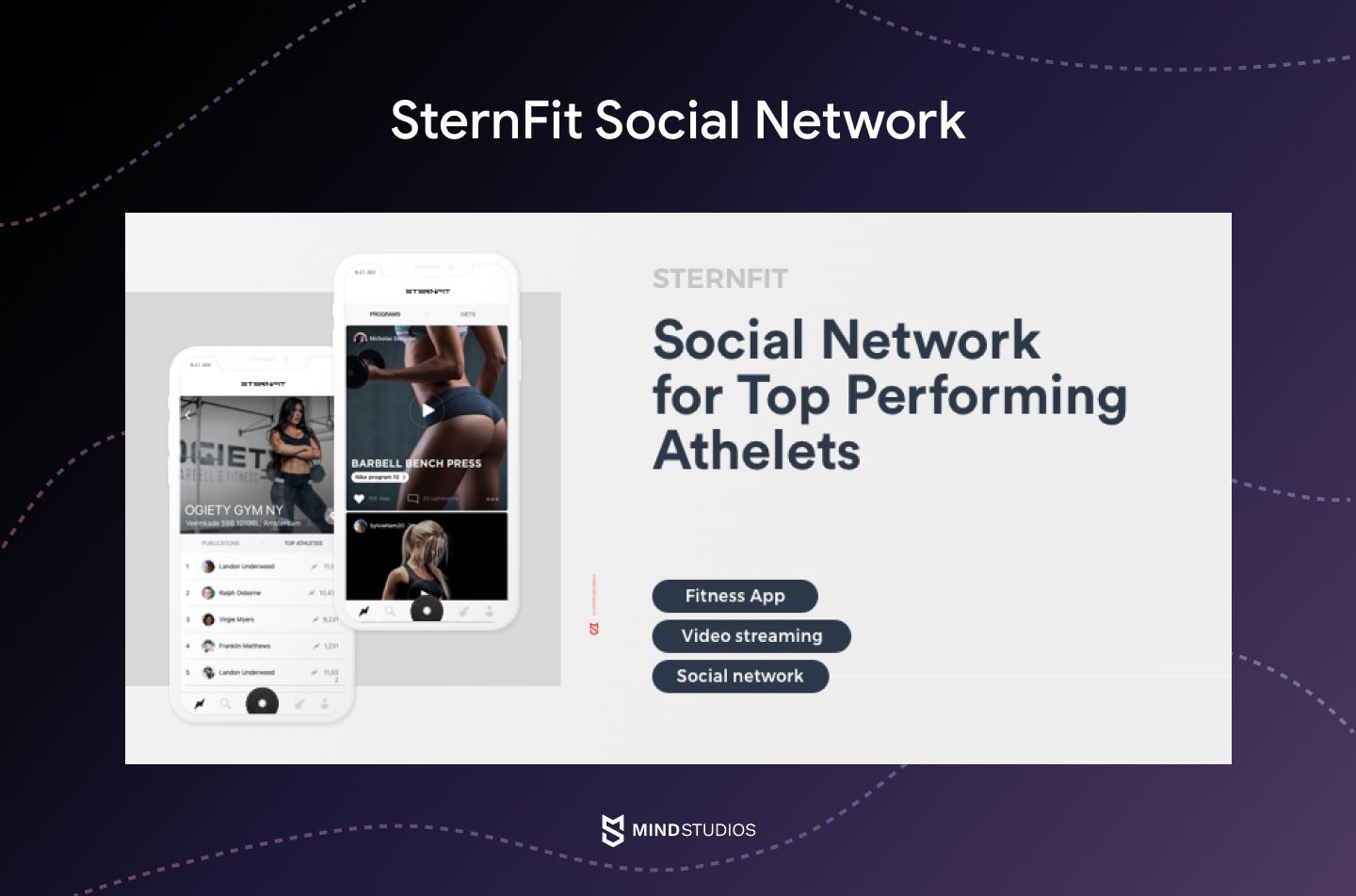
Analyzing cases of numerous startups on the market and our own experience, there’s a lesson to be learned about mobile applications. When there are already well-established players that have taken over the market, it might be a good idea to build a niche platform and target a specific user group.
For instance, imagine someone wants to create an eCommerce platform. Why build an Amazon clone that sells everything, when there’s an option of creating a platform that sells one type of product? This way, you can cater to the needs of very specific target users — and up your chances of winning them over.
The same point applies to building a photo-sharing or a social network app. Instead of making an app like Instagram, and blindly copying it, you can build a platform for travel bloggers, landscape photographers, pet lovers, and basically any other target audience that might need it.
Obviously, this decision shouldn’t be a shot in the dark. Before finalizing the concept of the project, you will need to analyze the market, define the target audience and their pain points, and work out unique tech solutions that users require. Luckily, that’s all part of the discovery stage provided by most professional development companies like Mind Studios.
Conclusion
According to a 2022 report by Dataportal, 93.4% of internet users are using social media apps. At the same time, the global social networking platform market is expected to reach a market size of USD 939.679 billion by 2026.
These numbers alone are inspiring enough for thousands of entrepreneurs to put all their efforts into building the next Instagram or Snapchat. However, while these platforms may serve as an inspiration, with the right development team you can go beyond copying them and create a one-of-a-kind mobile app users haven’t seen yet.
If you already have an idea in mind but don’t know how to implement it or how much it will cost you, feel free to request a free 45-minute consultation with Mind Studios. Our business development team will answer any questions you might have regarding the cooperation and provide you with possible solutions for turning your idea into a real app.

